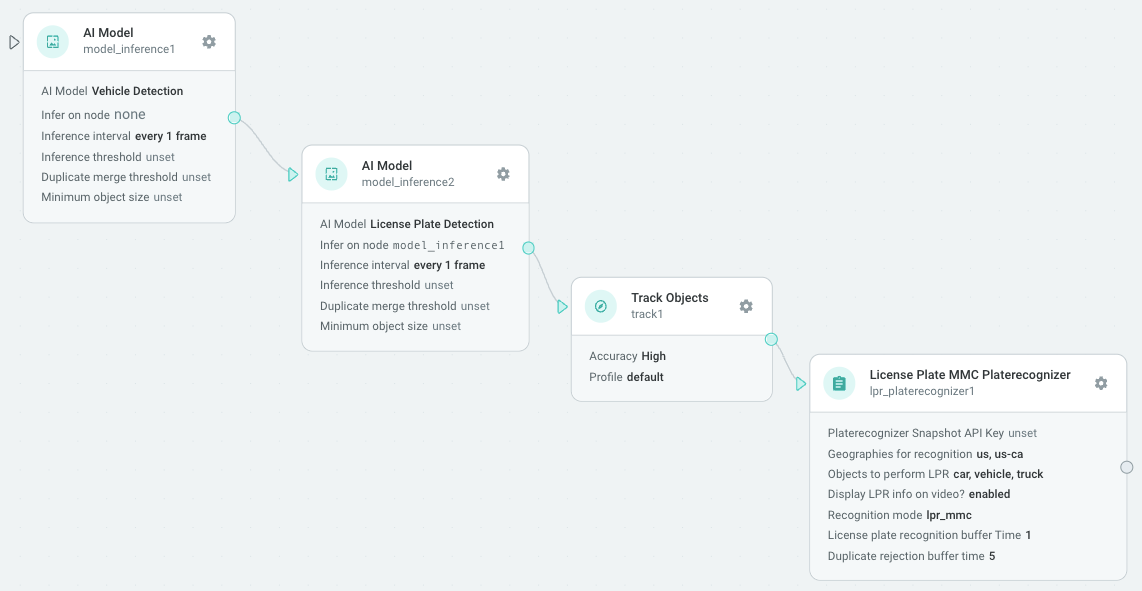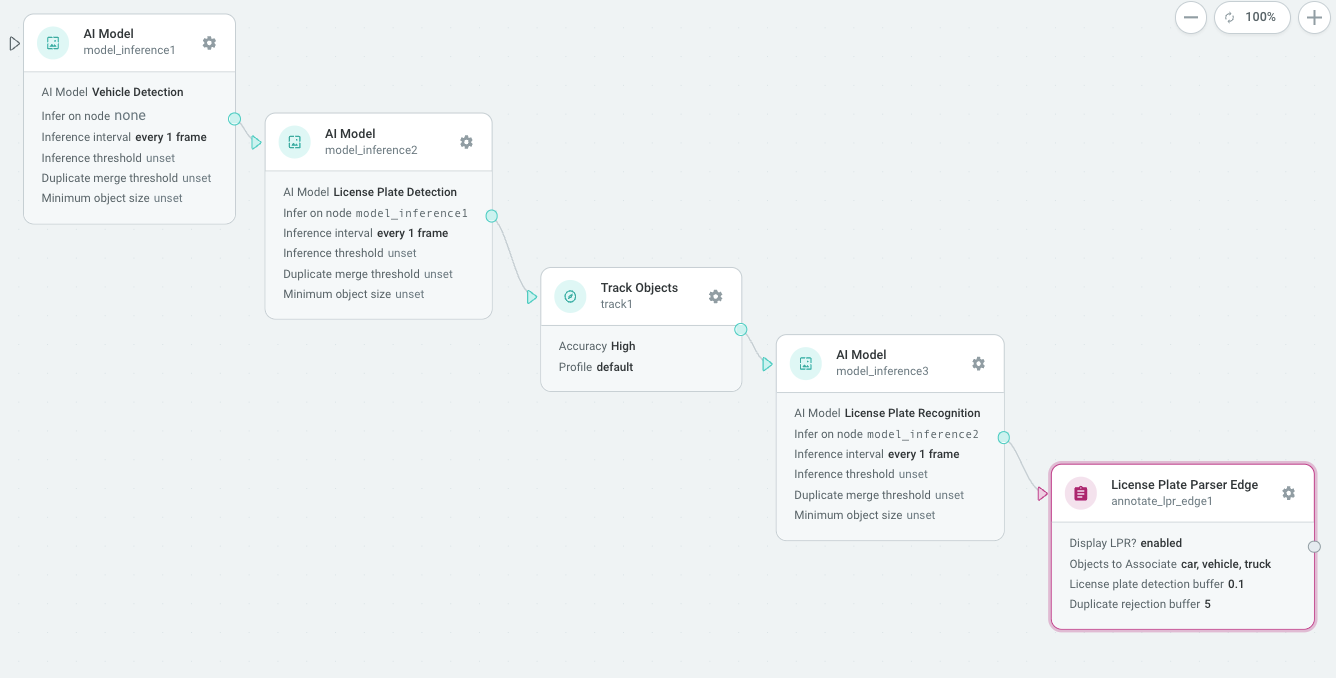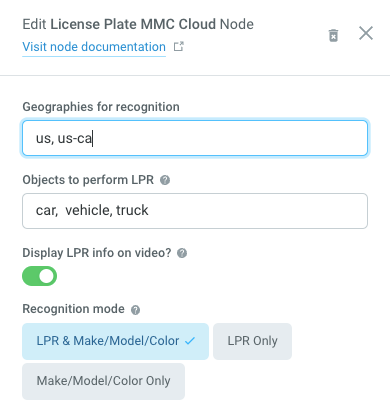License Plate Recognition Guide
Optimizing license plate and vehicle recognition analytics for various operational use cases
Overview
Lumeo provides multiple models and nodes to enable you to custom-build analytic pipelines for various license plate and vehicle recognition use cases. This guide provides direction on building the right pipeline to align with factors such as camera position, cost, and data output objectives for your specific LPR deployment.
Range of LPR Analytics
Lumeo includes multiple flavors of LPR analytics to meet varying user needs.
- Lumeo includes a high-performance cloud look-up service for a full function analytic that includes LPR with state/region/country, and accurate Make, Model, Type, and Color (MMC) output for each vehicle detected.
- If you choose not to go with the high accuracy cloud lookup approach, you can use Lumeo edge-based models to perform LPR-only detection, and basic vehicle Type and Color detection.
- Lumeo also has an integration with PlateRecognizer where you can use standard vehicle and plate detection output (images) from Lumeo and push those images to your own PlateRecognizer Snapshot account for lookup, recognition, and data reporting.
| High Performance Cloud Lookup Service | High Performance with Your PlateRecognizer Snapshot Account | Standard Performance with edge models and analytics | |
Lumeo Service Level | Premium | Core | Core |
LPR with State/Region/Country | Yes | Yes | No |
LPR only | Yes | Yes | Yes |
Vehicle Make | Yes | Yes | No |
Vehicle Model | Yes | Yes | No |
Vehicle Color | Yes | Yes | Yes |
Vehicle Type | Yes | Yes | Yes |
Building Pipelines for Various LPR Scenarios
So now that you know the capabilities made available by Lumeo, let's outline how to build LPR and MMC analytic pipelines based on how you intend to deploy. The first step is to identify the scenario you working with based on camera position.
- Will your camera be able to fully see and track vehicles so that both LPR and MMC is possible?
- Will your camera be positioned to zoom in on an area to capture the license plate and perform LPR, but not reliably capture the entire vehicle?
- If a zoomed in camera view, will the vehicle be in motion or will your environment enable a controlled stop (e.g., gate) to capture a license plate?
At a high level, if your camera is not capturing the entire vehicle, you will not be able to perform MMC operation. This also dictates Lumeo's recommended method to use various AI models within your pipeline.
LPR with Full Vehicle Tracking
For scenarios where the full vehicle can be detected and you are capturing vehicles as they drive through an area, Lumeo recommends deploying a pipeline that uses a Vehicle Detection model node to assist in focusing in on and detecting the License Plate Detection based on the detected vehicle.
| High Performance Cloud Lookup Service | High Performance with Your PlateRecognizer Snapshot account | Standard Performance with edge models and analytics | |
Lumeo Nodes | Detect with AI Model: Vehicle Detection Detect with AI Model: License Plate Detection Track Objects License Plate MMC Cloud Node | Detect with AI Model: Vehicle Detection Detect with AI Model: License Plate Detection Track Objects License Plate MMC PlateRecognizer | Detect with AI Model: Vehicle Detection Detect with AI Model: License Plate Detection Detect with AI Model: License Plate Recognition License Plate Parser Edge Node |
Sample Pipeline Connections | Figure 1 below | Figure 2 below | Figure 3 below |

Figure 1: High Performance Cloud LPR + MMC

Figure 2: High Performance LPR + MMC with PlateRecognizer Snapshot

Figure 3: Edge-based LPR only
In addition to LPR detection and recognition, a full view also enables capturing vehicle MMC. If using Lumeo's high-performance cloud service, add MMC detection by selecting LPR & Make/Model/Color within the License Plate MMC Cloud node.

If you have your own PlateRecognizer account, verify your account has MMC enabled. If so, that data will automatically be included in your lookup data stream for each vehicle. Finally, if using the standard edge model for LPR detection and recognition, you can add vehicle type and color detection into your pipelines using those available models.
LPR with a Zoomed View of Vehicle and License Plate
If you are able to position your camera such that the license plate and rear of the vehicle can easily be captured, you may not need to detect the vehicle at all in order to detect the license plate. In this case, referring to Figures 1-3 above, you can remove the dependency on the vehicle detection by simply removing the Infer with AI Model node with the Vehicle Detection selected. In these views, the License Plate detection model will work on its own.
Even without a vehicle track, and using the higher performance LPR+MMC cloud solution, you can still get good results with the rear of the vehicle in the camera view. However, depending on how zoomed in the view is (i.e., primarily seeing just the license plate, you may or may not be able to get consistent and accurate output for Vehicle MMC.
Updated 3 months ago
